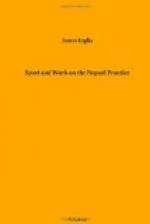The old Major came down to meet us, and a crowd of his men added their efforts to ours, to help the unfortunate elephant. We threw in bundle after bundle of grass, till we had the yielding sand covered with a thick passage of firmly bound fascines, on which the hathee, staggering and floundering painfully, managed to reach firm land. He was so completely exhausted that he could scarcely walk to the tents, and we left him there to the care of his attendants. This is a very common episode in tiger hunting, and does not always terminate so fortunately. In running water, the quicksand is not so dangerous, as the force of the stream keeps washing away the sand, and does not allow it to settle round the legs of the elephant; but on dry land, a dry fussun, as it is called, is justly feared; and many a valuable animal has been swallowed up in its slow, deadly, tenacious grasp.
In crossing sand, the heaviest and slowest elephants should go first, preceded by a light, nimble pioneer. If the leading elephant shows signs of sinking, the others should at once turn back, and seek some safer place. In all cases the line should separate a little, and not follow in each other’s footsteps. The indications of a quicksand are easily recognised. If the surface of the sand begins to oscillate and undulate with a tremulous rocking motion, it is always wise to seek some other passage. Looking back, after elephants have passed, you will often see what was a perfectly dry flat, covered with several inches of water. When water begins to ooze up in any quantity, after a few elephants have passed, it is much safer to make the remainder cross at some spot farther on.
In crossing a deep swift river, the elephants should enter the water in a line, ranged up and down the river. That is, the line should be ranged along the bank, and enter the water at right angles to the current, and not in Indian file. The strongest elephants should be up stream, as they help to break the force of the current for the weaker and smaller animals down below. It is a fine sight to see some thirty or forty of these huge animals crossing a deep and rapid river. Some are reluctant to strike out, when they begin to enter the deepest channel, and try to turn back; the mahouts and ‘mates’ shout, and belabour them with bamboo poles. The trumpeting of the elephants, the waving of the trunks, disporting, like huge water-snakes, in the perturbed current, the splashing of the bamboos, the dark bodies of the natives swimming here and there round the animals, the unwieldy boat piled high with how-dahs and pads, the whole heap surmounted by a group of sportsmen with their gleaming weapons, and variegated puggrees, make up a picturesque and memorable sight. Some of the strong swimmers among the elephants seem to enjoy the whole affair immensely. They dip their huge heads entirely under the current, the sun flashes on the dark hide, glistening with the dripping water; the enormous head emerges again slowly, like some monstrous antediluvian creation, and with a succession of these ponderous appearances and disappearances, the mighty brutes forge through the surging water. When they reach a shallow part, they pipe with pleasure, and send volumes of fluid splashing against their heaving flanks, scattering the spray all round in mimic rainbows.




